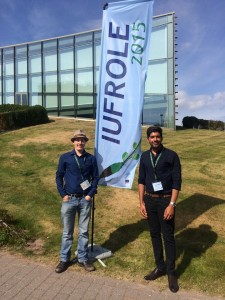Both Arjan Gosal and Paul Evans (PhD students) presented their research at the IUFROLE 2015 conference this year August. See below for the abstracts.
The Understated Value of Natural Historic Landscapes: Valuation through Spatial Analysis of Ecosystem Services
Arjan Gosal, Adrian Newton, Phillipa Gillingham
The Millennium Ecosystem Assessment highlighted the importance of quantifying ecosystem services as being pivotal to the allocation of environmental resources. Whilst biophysical and economic values are often used in management and conservation planning decision making, community ecosystem values are rarely quantified or defined clearly. Recreation, aesthetics and cultural ecosystem services are primary in this study. Various techniques, including participatory GIS, spatial mapping, and existing data sets are explored in relation to the New Forest. Situated on the South Coast of England, it is a prime example of a historic natural landscape, from being a medieval hunting ground to a commoning system that survives to the current day. England’s most recently designated national park has over 34,000 residents and many more visitors each year. With a clear need to understand the dynamics of how people value the various habitats and areas of this national park, this study aims to inform future management decisions made by the managing authority through a robust and adaptable methodology. Results from stakeholder engagement, including spatial mapping of services and a multi-spatial criteria analysis of various ecosystem services for differing management strategies are presented.
Dynamics of Ecosystem Services in Forest Ecosystems
Paul Evans, Adrian Newton, Elena Cantarello
Ecosystem services (ES) are the products of functioning ecosystems and so provide a convenient metric by which to test ecosystem functionality. Forests provide the greatest multi-functionality of any habitat, making them particularly important for ES provisions. However, environmental change and anthropogenic stressors are decreasing the condition of forests globally, inevitably reducing their functionality. Ecological thresholds and abrupt regime shifts are critical to identifying the resilience of ecosystems. While evidence exists for thresholds in aquatic ecosystems, prospects of them in terrestrial ecosystems are still largely theoretical, but would have major implications upon forest functions at the landscape and regional scales. To test whether thresholds exist in ES provisions and ecosystem functions as forests become increasingly degraded (termed forest collapse), various ES were measured over a gradient of collapse in the New Forest, UK – woodland that is currently undergoing major decline. Using replicated plots of different stages of forest collapse, relationships between various ES and collapse were measured. Preliminary results suggest that thresholds can be identified in some ES provisions, indicating that ES decrease more rapidly past a certain point.
